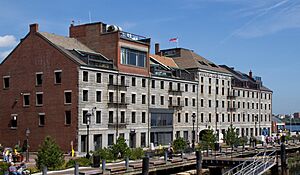Custom House Block (Boston) facts for kids
The Custom House Block is a historic building in Boston, Massachusetts. It was built a long time ago, between 1845 and 1848. This four-story building is made of strong granite and brick. It used to be a very important warehouse located right on Long Wharf, at the end of State Street. In the 1800s, this area was super busy! The Custom House Block played a big part in Boston's port life. Today, it is owned and cared for by private groups.
Contents
What is the Custom House Block?
The Custom House Block was originally built to be a warehouse. A warehouse is a large building where goods are stored before they are sold or shipped somewhere else. Imagine a giant storage locker for all sorts of products! This building helped Boston's port become a major center for trade.
How Was It Built?
The building was designed by a famous architect named Isaiah Rogers. He was known for designing many important buildings, especially those related to ports and trade. The Custom House Block has four floors and is made from two very strong materials: granite and brick. Granite is a very hard stone, and brick is also very durable. This made the building strong enough to hold many heavy goods.
A Busy Hub in Old Boston
In the 1800s, the Custom House Block was right in the middle of all the action. It was located on Long Wharf, which was Boston's busiest pier. A pier is like a long dock where ships can load and unload goods.
Why Was Long Wharf So Important?
Long Wharf was a very important place for several reasons:
- It was a major commercial port. This means it was a place where many ships came and went, bringing goods from all over the world.
- It was an embarkation point for travelers. People would get on ships here to travel to other cities or even other countries.
- The Custom House Block helped store all the goods that came off these ships. It was a key part of Boston's busy trade.
The Custom House Block Today
Even though it's an old building, the Custom House Block is still standing strong. It was renovated in 1973 by a group of architects called Anderson, Notter, Feingold. This renovation helped update the building while keeping its historic look. Today, it is a reminder of Boston's rich history as a major port city. It shows us how important trade and shipping were in the past.


